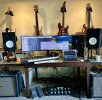brainleaf
Member
I recently watched "In the Room with John Petrucci, Tosin Abasi, and Devin Townsend" on Rick Beato's YouTube channel. Around minute 34, Rick Beato asks what real amps can do that modelers can't. Here is the link
I found the responses pretty interesting. I get the feeling that they are very biased toward using real amps, but I was curious if there is truth to what they're saying. Essentially the argument is that Tube Amps introduce a "randomness" that modelers don't have, and that IRs are simply a "Single instance in time". I don't have any experience playing tube amps, so I can't speak to the accuracy.
I do get the feeling that they are way more experienced playing real amps than using modelers (maybe with the exception of Devin Townsend), and so they are biased toward their preferred rigs. What do you think?
Edit: Regarding Petrucci claiming the Neural DSP "Does it the best" holds very little weight IMO since he has a product with them. I can't trust him to have an unbiased opinion on that point. Also just to clarify, these are three of my favorite guitarists of all time.
I found the responses pretty interesting. I get the feeling that they are very biased toward using real amps, but I was curious if there is truth to what they're saying. Essentially the argument is that Tube Amps introduce a "randomness" that modelers don't have, and that IRs are simply a "Single instance in time". I don't have any experience playing tube amps, so I can't speak to the accuracy.
I do get the feeling that they are way more experienced playing real amps than using modelers (maybe with the exception of Devin Townsend), and so they are biased toward their preferred rigs. What do you think?
Edit: Regarding Petrucci claiming the Neural DSP "Does it the best" holds very little weight IMO since he has a product with them. I can't trust him to have an unbiased opinion on that point. Also just to clarify, these are three of my favorite guitarists of all time.

